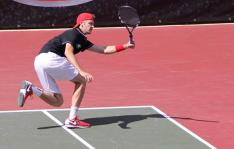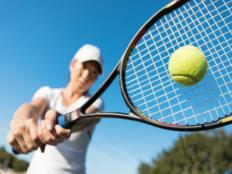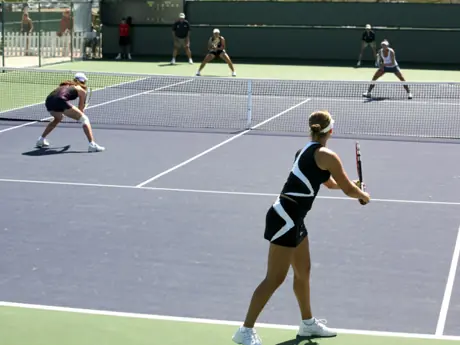Players like Sampras, Federer and the Williams sisters are all great players. Without diminishing their other skills, the foundation of their success is, without a doubt, the fact that they all have great serves. How many times have you seen Federer serve his way out of trouble in a big match? Sampras became virtually unbeatable on fast courts because of this shot. Serena scares her opponents simply by the fact that she has the biggest serve on the women's tour!
The rules aren't going to change anytime soon, so you should do everything you can to use them to your advantage. That means getting a great serve. The good news is, the more you practice, the better your serve! Plus, it's a shot you can develop on your own, without a partner.
Here are five components of a supersonic serve that you can start working on today.
The Grip
1 of 6
If you don't do so already, the quicker you can get to a continental grip, the better your serve will be. The continental grip is when you hold the racket as though you were holding an axe or a hammer. This grip is also called the chopper and the hammer grip.
The continental grip will allow you to produce a more streamlined and powerful service motion, allowing for the correct hand motion at contact that is a vital part of a good serve. One of the easiest ways to get the feel of this grip is to see if you can bounce a tennis ball with the bottom edge of your tennis racket. You'll know if you are not holding the racket correctly, because the edge of the racket will not be coming down directly on top of the ball.
Find:
Your Next Tennis EventThrowing Action
2 of 6
You'll need a powerful throwing action in order to develop a powerful serve. While many players discuss the fact that the tennis service action is similar to the baseball pitching action, there is one key difference. The baseball pitch is a flat, level throw, whereas the tennis serve is an upwards throwing action that would deliver the ball into the air if it were a baseball pitch.
Simply throwing tennis balls over the net will improve your throwing action, but you must make sure that you throw not only for distance but for height, as well. Try to throw the ball as far and as high as you can to really make this simple skill tennis-specific.
Find:
Your Next Tennis EventBall Toss
3 of 6
Too many players struggle with their ball toss. While it may look simple, without it your serve will never reach supersonic proportions. You simply need to line your straight arm up with the net post (to your right if right handed, left if left handed). Then, release–not throw or chuck–the ball when your hand reaches eye level. This should ensure that the ball comes out of your hand in a good position, and slightly forward into the court. The forward direction is vital, because it means that you can drive your weight and momentum forward into the ball and into the direction of the serve.
A good way to practice is to place a spare racket on the court in front of you. Place the handle just on the baseline and the head inside the court at a small angle (45 degrees right if you are right handed, left if you are left handed). Go through your service action as normal, but let the ball fall to the ground instead of serving. The ball should land on or near the racket head. Depending on where the ball lands, you will quickly see if you have any bad patterns emerging.
Find:
Your Next Tennis EventPronate
4 of 6
Pronation is the action of moving your thumb in towards the center of your body. When you are serving, your racket hand should be approaching the ball with the little finger first, if you have the correct grip. As you go to strike the ball, your hand needs to change direction by moving around so that the thumb moves towards the ball–just as though you were going to do a high five. At the pro level, you will see the butt of the racket (bottom of the handle) aimed at the ball when the player is in their pre-throw (or trophy) position. The racket ends up with the butt pointing up to the sky after the player has fully pronated their hand. When this is done at high speed it has the same effect as the movement that causes a whip to "crack."
A great way to practice this action is to stand on the service line facing the baseline with a tennis racket and a ball. Drop the ball over to the side of you that has the racket, and after one bounce try to hit the ball behind you and over the net. To do this effectively, you must pronate the hand and wrist in the desired fashion. The better you become, the higher and farther you will be able to hit the ball behind you.
Find:
Your Next Tennis EventPractice
5 of 6
60 percent of the game of tennis is actually serving and returning. Does your practice time reflect this? If you are like most people, you will spend most of your time hitting forehands, backhands and volleys. After that, you may hit a few serves to warm up, and then play some points. How much time do you spend actually practicing your serve?
Developing a big and accurate serve is all about getting on the court and practicing with power, as well as putting targets down to develop accuracy. A big part of your success in developing a consistent, reliable and powerful serve depends on the time you spend serving as many balls as you can.
Try adding one of these components into your routine for a week, before moving on to the next step. Before you know it, your opponents will start moving farther and farther back in an effort to try and deal with your delivery.






Discuss This Article